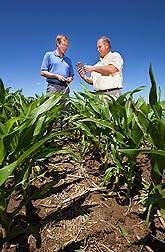
These studies at the Agricultural Research Service (ARS), USDA’s chief intramural scientific research agency, support the USDA priority of developing new sources of bioenergy.
Retaining carbon in the soil—called carbon sequestration—significantly affects soil fertility and greenhouse gas emissions, so it has a major impact on the long-term sustainability of bioenergy crop production. In one study, an ARS team conducted a 9-year investigation examining the impact fertilizer and harvest treatments had on soil carbon sequestration in biomass crops. Scientists contributing to the study included geneticist Ken Vogel, soil scientist Gary Varvel, agronomist Rob Mitchell, and soil scientist Ron Follett.
The team applied nitrogen fertilizer at three different rates to fields of perennial switchgrass and annual no-till maize to see how management practices affected soil carbon sequestration. Postharvest stover—corn plant residue left on the field after harvest—was not removed on half of the maize fields. On the other half of the maize fields, only half the stover was removed.
The scientists found that in the maize fields, soil carbon levels increased over time at all depths, with all nitrogen treatments, and with all postharvest stover management. They also determined that more than 50 percent of the soil carbon was found at depths between 1 foot and 5 feet below the soil surface.
More than 50 percent of the soil carbon in the switchgrass fields was also found between 1 and 5 feet below the soil surface. The average annual increase of soil carbon throughout the first 5 feet of subsoil also exceeded 0.9 tons per acre each year, which was equivalent to 3.25 tons of carbon dioxide per acre per year.
The team concluded that calculating soil carbon sequestration rates for bioenergy crops needs to factor in the effects of crop selection, soil differences, environmental conditions, and management practices. Additionally, the deep-rooted nature of these plants requires soil sampling to a depth of 5 feet to account for the increases in soil carbon.
Results from this study were published in Bioenergy Research.
Vogel recently retired from the ARS Grain, Forage, and Bioenergy Research Unit in Lincoln, Neb., where Mitchell still works. Varvel recently retired from the ARS Agroecosystem Management Research Unit in Lincoln, Neb., and Follett recently retired from the ARS Soil, Plant, and Nutrition Research Unit in Fort Collins, Colo.
Read more about this research in the February 2014 issue of Agricultural Research magazine.
Source
Agricultural Research Service, press release, 2014-02-20.
Supplier
ARS National Center for Agricultural Utilization Research
US Department of Agriculture (USDA)
Share
Renewable Carbon News – Daily Newsletter
Subscribe to our daily email newsletter – the world's leading newsletter on renewable materials and chemicals










